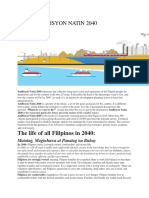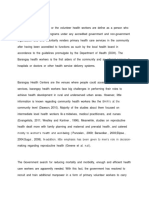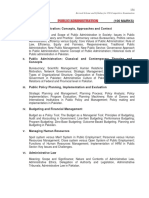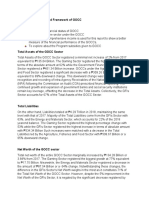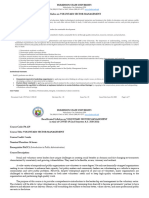Professional Documents
Culture Documents
Wellness Practices of Employees in A State University Bases For The Lagsik-Abtik' Wellness Plan
Original Title
Copyright
Available Formats
Share this document
Did you find this document useful?
Is this content inappropriate?
Report this DocumentCopyright:
Available Formats
Wellness Practices of Employees in A State University Bases For The Lagsik-Abtik' Wellness Plan
Copyright:
Available Formats
Volume 6, Issue 1, January – 2021 International Journal of Innovative Science and Research Technology
ISSN No:-2456-2165
“Wellness Practices of Employees in a State
University: Bases for the ‘Lagsik-Abtik’
Wellness Plan”
Lowena Bastida Gemota Bukidnon State University College of Education
Physical Education Department Malaybalay, City, Bukidnon, Philippines
Masters of Arts in Education, Major in Educational Administration Instructor 1
Abstract:- This descriptive study determined the extent level of wellness among individual employees, when
of wellness practices among the teaching and non- summed up describes the total organizational performance.
teaching employees of Bukidnon State University
during the second semester of school year 2018-2019. To help promote health and wellness among public
There were 333 randomly selected employee-participants employees in the Philippines, the government has enacted
who answered the adopted survey questionnaire on laws and mandates that required all public agencies to
wellness practices. The responses of the participants in implement regular wellness activities in their respective
the instrument and in the interview provided data on workplaces and to provide simple rules that encourage their
their practices in five dimensions of wellness, namely: employees to pursue a physically-active lifestyle at an
physical, intellectual, spiritual, social and emotional institutional level. The Civil Service Commission, for
dimensions. The participants also identified the example, had issued Memorandum Circular No. 8, s. 2011
challenges they have encountered in practicing which directed all heads of both national and local
wellness activities and some recommendations that government agencies, departments, corporations, and state
they think can help them address such challenges. colleges and universities to implement the physical fitness
Their responses were guided by a 5-point Likert scale program called “Great Filipino Workout.” To develop a
and the data gathered were treated using mean and healthy and alert workforce, the system of rules mandated
standard deviation. The results of the study revealed that all government offices to parcel out reasonable time for
the teaching and non-teaching employees of Bukidnon regular physical fitness program among their respective
State University always practiced spiritual and employees. Moreover, said memorandum pinpointed key
emotional wellness activities, often practiced activities persons in promoting and implementing the said program,
for social and intellectual wellness and sometime namely: health professionals, community health workers,
practiced physical activities. The employees of the health and sports coordinators, human resource officers, and
university also identified lack of interest and motivation, physical education teachers.
lack of time, and unstable body condition as their
challenges in practicing wellness activities. Teachers and non-teaching employees of state
universities were observed to be prone to stress; thus, they
I. INTRODUCTION need to engage in activities that promote overall wellness.
The demands of maintaining outstanding performance, plus
Attaining wellness in all dimensions is necessary for other concerns in the work environment and family, may
all people, specifically for employees. To be truly healthy, contribute to employees’ stress. The complexity and volume
employees need to possess a sound mind and body, stable of teaching or office tasks may cause university employees
emotional, positive social inclination, professional to neglect other dimensions of their wellbeing. Furthermore,
excellence, and spiritual maturity. Such conditions are said as observed, busy employees tend to have not enough time
to influence personal health, happiness, and productivity. to read intellectual and spiritual literature and may be
Hence, every employee needs to be aware of and makes too tired to join community activities on weekends. They,
choices towards a healthy and fulfilling life. likewise, appear to lose interest in engaging in other creative
projects for personal growth.
According to Bezner (2015), the status of health and
wellness among employees has a direct impact on their work There is, therefore, a felt need that a study on
performance as well as on the overall organizational wellness practices among the teaching and non-teaching
success. For regular employees who are working full- time, employees of Bukidnon State University be conducted to
that is eight hours a day, five days a week, self-care draw data that are useful in designing the most appropriate
practices may become both personal as well as professional wellness intervention plan. The said intervention plan, once
responsibilities. In other words, in providing services to institutionalized and implemented, is envisioned to raise
clienteles, every paid employee has an ethical obligation to employees’ level of personal wellness in all dimensions. The
attend to his or her health and well-being so as not to findings of this study may also be utilized as tangible
compromise the quality of services he/she is delivering. The evidence that will help convince the administration of the
IJISRT21JAN601 www.ijisrt.com 1750
Volume 6, Issue 1, January – 2021 International Journal of Innovative Science and Research Technology
ISSN No:-2456-2165
university and other neighboring institutions to invest in about finding balance in these key dimensions.
other human resource programs. The ultimate anticipated
result of this study is an improved individual and The second and the third boxes in Figure 1 represent
organizational performance. the challenges that the teachers and non-teaching employees
of Bukidnon State University experience in their wellness
II. CONCEPTUAL FRAMEWORK activities and the recommended intervention to address
them, respectively. According to studies, the success of
This study was primarily anchored on the Wellness employees’wellness activities depends on some factors such
Motivation Theory (WMT) of. The theory states that as their interest in participation, financial pressure, and the
personal motivation to engage in health and wellness level of commitment by organizational leadership
activities is influenced by individual values and (Person, 2010). Other factors include insufficient incentives,
resources. Hence, the kind and extent of wellness activities inconvenient locations, time limitations, not interested in
that people do vary from person to person, depending on topics presented, marketing, health beliefs, and uninterested
their contextualized needs and opportunities and choices in the program (Schreiner, 2018). To reap the potential
toward a more successful existence. Moreover, the benefits of personal and workplace wellness programs,
motivation to practice personalized wellness activities may employees and employers must overcome these hurdles and
change from time to time because it is a dynamic and goal- stay optimistic in their dedication to establishing programs
directed behavior leading to new and positive health that promote employee health and wellness.
patterns.
The study is further anchored on the Social and
Behavioral theory of Glanz (2016). This theory states that
individual choices on foods and activities are influenced
by personal preferences, habits, nutrition information,
availability, cost, and placement, among other things.
The process of choosing is complex and determined not
only by multiple factors but by factors at multiple levels.
One relevant concept from Glanz’s theory is that any
intervention to promote and sustain wellness programs
should not only target individuals but should also include
organizational and environmental factors influencing health
behavior.
Moreover, the present study was also supported by Fig 1:- The schematic diagram showing the parameters of
three memorandum circulars issued by the Philippine Civil the study.
Service Commission that required public agencies, including
state universities, to integrate wellness activities in their III. STATEMENT OF THE PROBLEM
workplaces, namely: CSC M. C. no. 38 in 1992 (Physical
and Mental Wellness Program for Government Personnel), This study determined the wellness practices of
CSC M. teaching and non- teaching employees in Bukidnon State
University during the 2nd semester of school year 2018-
C. no. 6 in 1995 (The Great Filipino Workout), and 2019. Specifically, it answered the following questions:
CSC M. C. no.8 of 2011 (Reiteration of Physical Fitness
Program ‘Great Filipino Workout’). Said issuance required To what extent did the university employees practice
government employees to participate in organizational wellness activities in the following dimensions:
wellness and fitness programs,which aimed at inculcating Physical dimension;
among Filipino employees the importance of a healthy Intellectual dimension;
lifestyle as a strategy to reduce the level of the risk factors Spiritual dimension;
of heart diseases. Social dimension; and
Emotional dimension?
Figure 1 shows the conceptual framework of the study. What were the challenges that university employees
The first box of the diagram represents the different encountered in practicing wellness activities?
wellness practices of teachers and non-teaching employees What institutional intervention plan could be designed to
of Bukidnon State University that were categorized help university employees cope with the challenges they
according to five of Hettler’s (1976) and Swarbrick and experienced in practicing wellness activities?
Yudof’s (2015) dimensions of wellness, namely: physical,
intellectual, spiritual, social, and emotional. These are the IV. METHODOLOGY
dimensions of wellness that teachers and the rest of school
employees need to attain and sustain to be personally This chapter presents the methods and procedures used
motivated in life and become highly effective in their to gather and interpret data from the responses of the
respective work environment. Achieving holistic wellness is participants. It describes the research locale, the participants
IJISRT21JAN601 www.ijisrt.com 1751
Volume 6, Issue 1, January – 2021 International Journal of Innovative Science and Research Technology
ISSN No:-2456-2165
of the study, the research instrument, the administration of mature emotionally, they also become spiritually mature.
the instrument, the scoring procedure, and the treatment of Moreover, such relationship may be possible because
data. This study used the descriptive method of research both are concerned about living a meaningful life despite its
using an adapted survey questionnaire on the five circumstances. Spiritual wellness aims at achieving inner
dimensions of wellness practices. peace and harmony, while emotional wellness helps people
cope with stress by attaining inner happiness and
This study conducted at Bukidnon State University, a satisfaction. Hence, churches and religious fellowships are
state-owned higher education institution located in integral partners of universities and other institutions in
Malaybalay City, Bukidnon. improving both spiritual and emotional wellness among
their employees.
V. RESULTS AND DISCUSSION
The findings also revealed that Bukidnon State
Summary Table on Practices of Bukidnon University employees encountered few challenges in
the Wellness State University doing wellness activities, such as, lack of interest and
Employees in Five undefined motive or purpose (Schreiner, 2018; Edmunds,
Dimensions Hurst and Harvey, 2013), lack of time (Person, 2010), and
overweight (Ball et al, 2010). The second most prevalent
Dimensions of SD Qualitative barrier to employees’ engagement to wellness activities is
Wellness Mean Description their lack of time. This particular result is similar to the
Spiritual Dimension 0.91 Always Practiced finding of Hoare et al. (2017), (Kruger, 2007; Daskapan et
4.34 al. 2006). Another challenge that hindered few university
Emotional Dimension 0.84 Always Practiced employees from engaging with physical activities was being
4.28 overweight- that means having a weight that is above the
Social Dimension 0.92 Often Practiced average Body Mass Index (BMI).
4.06
Intellectual 0.91 Often Practiced VI. FINDINGS
Dimension 3.56
Based on the results of the study, the following
Physical Dimension 0.81 Sometimes
findings emerged:
3.13 Practiced
The teachers and non-teaching employees of Bukidnon
Overall 3.87 0.88 Often Practiced
State University always practiced spiritual and emotional
Table 1:- Summary Table on the Wellness wellness, often practiced social and intellectual wellness,
and sometimes practiced physical wellness.
The overall result shows that the teachers and non- The teaching and non-teaching employees of Bukidnon
teaching employees of Bukidnon State University practiced State University identified lack of interest, lack of time,
various activities that helped them attain personal wellness. body condition, heavy workload, time constraint,
However, the extent of these practices varies from always financial, and unavailability of a university wellness
practiced, often practiced, and sometimes practiced. Among center as their challenges in practicing wellness
the five components of wellness considered in this study, the activities.
spiritual dimension got the highest mean, while the physical A proposed institutional wellness intervention called
aspect got the lowest overall mean rating. Hence, the study Lagsik Abtik was designed for the Bukidnon State
found out that university employees may have considered University employees to enhance wellness practices.
spirituality important and easy to attain. On the other hand,
doing physical fitness activities have appeared challenging VII. CONCLUSIONS
among university employees. This result affirms the idea of
Laws, et al. (2013) that people find physical activities less The following conclusions were drawn based from the
practical because, at present, machines and technology findings of the study:
make many tasks easy, fast, and do not require much The teaching and non-teaching employees of Bukidnon
physical strength of workers. State University practiced spiritual and emotional
wellness all the time. They practiced social and
The spiritual and emotional dimensions have close intellectual wellness most of the time. However, they
overall mean ratings. This result partially supports the practiced physical wellness occasionally.
concept that to some extent, the various components of Some personal and environmental factors have affected
wellness somewhat interconnect (Hettler,1976; Swarbrick the university employees’ practices in wellness in the
and Yudof, 2015; National Institute for Health, 2010) and five dimensions.
that wellness is both a dynamic process of different The designed wellness intervention is in compliance with
components and an outcome of their integration (American existing laws and memorandum circulars of the
Physical Therapists Association, 2015; Khan, 2017). This government, policies and guidelines of Bukidnon State
finding is similar to those of Rebisz (2007) and Koenig University. It is also a collaborative wellness
(2004) that there is indeed a connection between emotional enhancement program.
and spiritual dimensions of wellness and that as persons
IJISRT21JAN601 www.ijisrt.com 1752
Volume 6, Issue 1, January – 2021 International Journal of Innovative Science and Research Technology
ISSN No:-2456-2165
RECOMMENDATIONS [7]. Brookfield, S. D & Preskill, S. (2005). Discussion as a
Way of Teaching: Tools and Techniques for
To enhance employees’ holistic wellness and their University Teachers. Buckingham: SRHE and Open
respective work performance, the following are University Press.
recommended: [8]. Catsouphes, M. P., James, J.B., Costa, C. M. (2015).
The university, through its Gender and Development Workplace-Based Health and Wellness Programs: The
Unit in collaboration with the Physical Education Intersection of Aging, Work, and Health. The
Department, faculty association, the non-teaching Gerontologist, Volume 55, Issue 2, Pages 262–270,
employees association and the office of the human https://doi.org/10.1093/geront/gnu114.
resource may work hand in hand to implement the [9]. Centers for Disease Control and Prevention (2007).
comprehensive and sustainable wellness program Overcoming Barriers to Physical Activity. Physical
designed in the study for the university. Activity for Everyone.
Wellness activities may be conducted inside the campus www.cdc.gov/nccdphp/dnpa/physical/life/overcome.ht
during official working hours at least twice a month, m.
preferably in the afternoon of Friday. This scheme will [10]. Civil Service Commission Memorandum Circular no.
create an impression among university employees that 38. (1992).
the administration is committed to help them achieve [11]. Physical and Mental Fitness Program for Government
maximum wellness. Employees.
Attendance and active involvement of employees during [12]. Retrieved from https://csguide.org/items/show/144.
the conduct of wellness activities may be strictly [13]. Civil Service Commission Memorandum Circular no.
monitored by the wellness focal person in each 06. (1995). The Great Filipino Workout. Retrieved
department and if possible be integrated in the IPCR from https://csguide.org/ items/show/247.
under Major Final Output: Support Function. [14]. Civil Service Commission Memorandum Circular no.
Studies on the impact of ‘Lagsik-Abtik’ wellness 21. (2009). Civil Servants’ Health and Wellness
program on different dimensions of wellness is also Month. Retrieved from
recommended at least 3 years after its implementation. https://csguide.org/items/show/630.
[15]. Civil Service Commission Memorandum Circular no.
REFERENCES 08. (2011).
[16]. Reiteration of the Physical Fitness Program “Great
[1]. Affeldt, D. L. & MacDonald, D. A. (2010). The Filipino Workout”. Retrieved from
relationship of spirituality to work and organizational https://csguide.org/items/show/676.
attitudes and behaviors in a sample of employees from [17]. Congress of the Philippines (2017). Republic Act No.
a health care system. The Journal of 11036. Retrieved from
Transpersonal Psychology, Vol. 42, No. 2. https://www.officialgazette.gov.ph/downloads/2018/06
[2]. American Academy of Family Physicians (2011). jun/20180620-RA-11036- RRD.pdf.
Family Physician Burnout, Well-Being, and [18]. Daskapan, A., Tüzün, E. & Eker, L. (2006). Perceived
Professional Satisfaction. Barriers to Physical Activity in University Students.
https://www.aafp.org/about/policies/all/physician- Journal of Sports Science and Medicine. 5. 615-20.
burnout.html. [19]. Dumdumaya, R. (2013). Outdoor Recreation Activities
[3]. Anspaugh, D. J., Hamrick, M. H., and Rosato, F. D. and Social Skills of College Students. Unpublished
(2004). Wellness: Concepts and Applications, 6th ed. master’s thesis. University of Mindanao.
Boston: McGraw Hill Ball, K., Crawford, D., Owen, [20]. Edmunds, S., Hurst, L. & Harvey, K. (2013). Physical
N., (2000).Too fat to exercise? Obesity as a barrier to activity barriers in the workplace: An exploration of
physical activity. Australian and New Zealand Journal factors contributing to non-participation in a UK
of Public Health, vol. 24 no. 333 1. workplace physical activity intervention. International
[4]. Baruth, M. Sharpe, P. A. Medina, D. P. Wilcox, S. Journal of Workplace Health Management. 6. 227-
(2015). Perceived barriers to exercise and healthy 240. 10.1108/IJWHM-11-2010-0040.
eating among women from disadvantaged [21]. Fisher, J. (2011). The Four Domains Model:
neighborhoods: Results from a focus groups Connecting Spirituality, Health and Well-Being,
assessment. Religions, vol 2.
[5]. Bezner, J.R. (2015). Promoting health and wellness: [22]. Flynn, S., Jellum, L., Howard, J., Moser, A., Mathis,
implications for physical therapist practice. Physical D., Collins, C., Henderson, S., and Watjen, C. (2018).
Therapy. Vol. 95, pages1433-1444. Concepts of Fitness and Wellness. Nursing and Health
[6]. Bivins,T.H.(2013).Responsibility and Accountability. Sciences Open Textbooks.
Retrieved from https://oer.galileo.usg.edu/health-textbooks/4.
https://www.semanticscholar.org/paper/Responsibility- [23]. Garfield, C. F., Isacco, A., Sahker, E. (2012). Religion
and-Accountability and Spirituality as Important Components of Men’s
Bivins/0f681c22aa5e54c1f78d9c6de0f6948f4690 Health and Wellness: An Analytic Review.
e1c9. https://doi.org/10.1177/1559827612444530.
IJISRT21JAN601 www.ijisrt.com 1753
Volume 6, Issue 1, January – 2021 International Journal of Innovative Science and Research Technology
ISSN No:-2456-2165
[24]. Hawks, S.(2004) Spiritual Wellness, Holistic Health, [41]. Nuttall, M.S. (2015). Barriers and facilitators to
and the Practice of Health Education. Journal of physical activity amongst overweight and obese
Health Education. Association for the Advancement women in an Afro-Caribbean population: A qualitative
of Health Education, vol. 35. study. International Journal of Behavioral Nutrition
[25]. Health Advocate Incorporated (2016). Setting up a and Physical Activity, vol. 12, Article number: 97
Wellness Program: A Checklist for Success. (2015).
https:/www.shfmonline.org/CMS/ [42]. Ohuruogu, B. (2016). The Contributions of Physical
Resources/bok/nutrition%20&%20wellness/workplace Activity and Fitness to Optimal Health and wellness.
wellness checklist.pdf. Journal of Education and Wellness. Vol.7, No. 20.
[26]. Hettler, B. (1976). Six Dimensions of Wellness Model, Ebonyi State University.
National Wellness Institute, Inc. NationalWellness.org [43]. O’Lenic, C., & Arman, J. F. (2005). Anger
| 715.342.2969. management for adolescents A creative group
[27]. Hoare, E., Stavreski, B., Jennings, G. L., & Kingwell, counseling approach. VISTAS: Compelling
B. A. (2017). Perspectives on Counseling, pp. 55-58. Alexandria,
[28]. Exploring Motivation and Barriers to Physical Activity VA: American Counseling Association.
among Active and Inactive Australian Adults. [44]. Person, A., Colby S., , Bulova, J., and Janie
Metabolic and Vascular Physiology. Baker Heart and Whitehurst Eubanks, J. (2010). Barriers to
Diabetes Institute, Melbourne, VIC 3004, Australia. participation in a worksite wellness program. Nutrition
[29]. Huberty, J.L., Ransdell ,L.B,, Sidman C,, Flohr, J.A., Research and Practice. Published online doi:
Shultz, B., Grosshans,O, & Durrant, L. (2008). [10.4162/nrp.2010.4.2.149].
Explaining long-term exercise adherence in women [45]. Philippine Congress (2011). R. A. 11058. Retrieved
who complete a structured exercise program. Research from
Quarterly for Exercise and Sport. .79(3): 374- 84. https://www.senate.gov.ph/republic_acts/ra%2011058.
[30]. Khan, S. (2017). Concept of health, fitness, and pdf
wellness. Retrieved from [46]. Philippine Congress (2011). R. A. 6713. Retrieved
https://www.researchgate.net/publication/318561371_ from https://www.
Concept_of_Health_Fitness_and_Wellness. officialgazette.gov.ph/1989/02/20/republic-act-no-
[31]. Khatri, Puja & Gupta, Pragya. (2017). Workplace 06713/.
Spirituality: A Predictor of Employee Wellbeing. [47]. Prabhu, G. S., Yen, J. T. M.,Amalaraj, J. J. P., Jone, E.
Asian Journal of Management. 8. 284. 10.5958/2321- T. Y., and Kumar, N. (2016). Anger Management
5763.2017.00044.0. among Medical Undergraduate Students and Its Impact
[32]. Kilewo, E. & Frumence, G. (2015). Factors that hinder on Their Mental Health and Curricular Activities.
community participation in developing and Hindawi Publishing Corporation. Education Research
implementing comprehensive council health plans in International. Volume 2016, Article ID 7461570.
Manyoni District, Tanzania. Global Health Action. 8. Retrieved from http://dx.doi.org/10.1155/2016/
26461. 10.3402/gha.v8.26461. 7461570.
[33]. Koenig, H. (2004). Spirituality, Wellness, and Quality [48]. Prem, S. (2015). A Positive Attitude Leads to Success
of Life, Sexuality, Reproduction and Menopause. Vol and Happiness.
2, issue 2. https://www.linkedin.com/pulse/positive-attitude-
[34]. Kruger, J., Yore ,M. M., Bauer, D. R, & Kohl ,H. leads- success-happiness-dr-sanjay-prem.
W.(2007). Selected barriers and incentives for [49]. RAND Corporation (2013). Workplace Wellness
worksite health promotion services and policies. Programs Study.
American Journal: Health Promotion, May-Jun; https://www.rand.org/content/dam/rand/pubs/research-
21(5):439-47. report s/RR200/RR254/RAND_RR254.pdf.
[35]. Laws, R., St.George, A., King, L., & Risse, C. (2013). [50]. Rebisz, J. B. (2007). The Emotional Well-being and
Employer Perspectives of Workplace Health Spiritual Maturity Connection: A Study on the
Promotion. Relationship between Emotional Health and
[36]. Melnyk, B. M.& Neale,S. (2018). Intellectual Spirituality. Counselor Education Master's Theses.
wellbeing. American Nurses Today.Vol. 13, No. 5. http://digital commons.brockport.edu/edc_theses/87.
[37]. Miller, C. (2009). Nursing for Wellness in Older [51]. Recovery Innovations (2014). Hope, choice,
Adults: 6th Edition. empowerment, recovery, culture, spirituality. Voice,
[38]. Lippincott Williams & Wilkins. Retrieved from vol. 6, issue 3.
https://www. [52]. Schreiner, E. (2018) Barriers to a Wellness Program in
academia.edu/27665300/miller_Nursing_for_Wellness the Workplace.
_in_older_a dult.pdf. [53]. Small Business Chron.com. Retrieved from
[39]. National Institute of Health (2011). Your Healthiest http://smallbusiness.chron.com/barriers-wellness-
Self: social wellness checklist. Retrieved from programs-worplace- 12851.html.
https://www.nih.gov/health- information/social- [54]. Schwartz, S. A. (2013). At the Cost of Your Life:
wellness-toolkit. Social Value, Social Wellness. EXPLORE the Journal
[40]. Northern Michigan University, (2011) Social wellness. of Science and Healing. Vol 9 (6):351-354.
Wildcat Wellness Connection, vol.1, issue 11.
IJISRT21JAN601 www.ijisrt.com 1754
Volume 6, Issue 1, January – 2021 International Journal of Innovative Science and Research Technology
ISSN No:-2456-2165
[55]. Smith, E. (2016). Spiritual Wellness: What is Your
Meaning and Purpose? Journey to a healthier You.
Vol. 13, no. 4
https://www.lhsfna.org/index.cfm/lifelines/september-
2016/spiritual-wellness-what-is-your-meaning-and-
purpose/.
[56]. Sörqvist, P. & Marsh, J. E. (2015). How Concentration
Shields Against Distraction. Retrieved from
https://doi.org/10.1177/09637214 15577356.
[57]. Southern Adventist University (2010). Dimensions of
Wellness: Social Wellness. Wellness Pointers. Vol 21,
issue 16
[58]. Swarbrick, M. & Yudof, J. (2015). Wellness in the
8 Dimensions. 10.13140/RG.2.1.2650.2804.
[59]. Syed, S., Rehman, R., Hussain, M. & Shaikh, S.
(2017). Intellectual wellness in medical university
teachers: Gender based comparison. Journal of the
Pakistan Medical Association. Vol.67, No.5, 782-4.
[60]. University of Wisconsin (2015). Health & Wellness –
Employee Programs.
https://www.wisconsin.edu/uwsa/hr/topics/wellness/he
alth-wellness- employee-programs/.
[61]. World Health Organization (2018). Healthy Diet.
https://www.who. int/news-room/fact-
sheets/detail/healthy-diet.
[62]. Yadamsuren, B. & Erdelez, S. (2010). Incidental
Exposure to Online News. Synthesis Lectures on
Information Concepts, Retrieval, and Services.
(https://doi.org/10.2200/S00744ED1V01Y20161
1ICR054).
[63]. Zamora, C. F. & Fernandez, M. K. (2016). A
Grounded Theory of Filipino Wellness
(Kaginhawaan). Psychological Studies. 61.
10.1007/s12646-016-0373-7.
IJISRT21JAN601 www.ijisrt.com 1755
You might also like
- Public Policy and Program Administration in the Philippines: A Critical DiscourseDocument6 pagesPublic Policy and Program Administration in the Philippines: A Critical Discourseluis pangan100% (1)
- Master's Thesis on HRH Performance Factors in PhilippinesDocument85 pagesMaster's Thesis on HRH Performance Factors in PhilippinesMark A. Catiil100% (1)
- Case Studies On ODDocument3 pagesCase Studies On ODAnonymous KK3PrbNo ratings yet
- The Quality of Public Services in The Philippines Villamejor MendozaDocument23 pagesThe Quality of Public Services in The Philippines Villamejor MendozaphiongskiNo ratings yet
- OB human behavior organizational performanceDocument3 pagesOB human behavior organizational performanceArlene Roque Parobrob SantosNo ratings yet
- Management Capability and Emotional CompDocument18 pagesManagement Capability and Emotional CompBeverly A. CannuNo ratings yet
- About Ambisyon Natin 2040Document6 pagesAbout Ambisyon Natin 2040Ronie ApellidoNo ratings yet
- Practical Principles For Public AdministrationDocument8 pagesPractical Principles For Public AdministrationLordy Villa Abrille100% (1)
- 1.2 Good Governance and Public Administration - 1910703929Document7 pages1.2 Good Governance and Public Administration - 1910703929Venus TongalagNo ratings yet
- dm2021 0434Document51 pagesdm2021 0434Bea Magbanua100% (1)
- Governance and International Assistance For Building Human Development: A Review of UNDP Activities Programme in Ekiti State, NigeriaDocument7 pagesGovernance and International Assistance For Building Human Development: A Review of UNDP Activities Programme in Ekiti State, NigeriaAJHSSR JournalNo ratings yet
- Training Needs and Development of BHW-1Document10 pagesTraining Needs and Development of BHW-1Mica Marie Bansil100% (1)
- Job Sharing: A Study of Women Primary Teachers' Career ExperiencesDocument30 pagesJob Sharing: A Study of Women Primary Teachers' Career Experiencessabeen ansariNo ratings yet
- A Research Paper On Work Life Balance of Employees at Sbi: With Special Reference To Bhavnagar CityDocument4 pagesA Research Paper On Work Life Balance of Employees at Sbi: With Special Reference To Bhavnagar CityAiswarya Ab100% (1)
- Psats DSWDDocument62 pagesPsats DSWDHijo del DuqueNo ratings yet
- Accessibility and Quality of Health Care ServicesDocument69 pagesAccessibility and Quality of Health Care Servicesyra capili100% (1)
- Public Administration SyllabusDocument3 pagesPublic Administration SyllabusEhsanMemonNo ratings yet
- Positive Youth Development Through Leisure: Confronting The COVID-19 PandemicDocument20 pagesPositive Youth Development Through Leisure: Confronting The COVID-19 PandemicZaira Magayon100% (1)
- Youth Participation in The Local Government ProcessDocument6 pagesYouth Participation in The Local Government ProcessNors CruzNo ratings yet
- Government Budgeting PrinciplesDocument10 pagesGovernment Budgeting PrinciplesDenika ToledoNo ratings yet
- PCW 9.10.2020 2.review of Gender Mainstreaming ConceptsDocument59 pagesPCW 9.10.2020 2.review of Gender Mainstreaming ConceptsDaniphine A. Badua100% (1)
- Book ReviewDocument8 pagesBook ReviewLeilani Bueno CarinoNo ratings yet
- Thesis CompleteDocument58 pagesThesis CompleteAleAhmedNo ratings yet
- Powerpoint-Leadership FinalDocument35 pagesPowerpoint-Leadership FinalJeffrey Santander100% (1)
- Guidelines On LYDP CBYDP and ABYIPv2024 FINALDocument31 pagesGuidelines On LYDP CBYDP and ABYIPv2024 FINALDILG IBAJAYNo ratings yet
- VII. Situational Analysis (FINAL)Document2 pagesVII. Situational Analysis (FINAL)Paulo AlunanNo ratings yet
- Competency-Based Job DescriptionDocument2 pagesCompetency-Based Job DescriptionRoxanne MontanaNo ratings yet
- Performance of 1sangguniang Kabataan Officials in Barangay Adlay As Mandated by Republic Act No. 10742 For PublicationDocument17 pagesPerformance of 1sangguniang Kabataan Officials in Barangay Adlay As Mandated by Republic Act No. 10742 For PublicationSHENSAI CASTILLONo ratings yet
- 4 P'sDocument23 pages4 P'sMeetch Soriano100% (1)
- Work Motivation and Job Satisfaction As Predictors of Employee Organizational Commitment in Public Service OrganizationsDocument11 pagesWork Motivation and Job Satisfaction As Predictors of Employee Organizational Commitment in Public Service OrganizationsSteven JonesNo ratings yet
- Mauricio, Lester (SWPPDM Midterm Exam) - Wps OfficeDocument4 pagesMauricio, Lester (SWPPDM Midterm Exam) - Wps OfficeLeo VelascoNo ratings yet
- Level of Competence of Barangay Health WorkersDocument17 pagesLevel of Competence of Barangay Health WorkersJecel MacapepeNo ratings yet
- Concepts and Challenges in The Use of Knowledge-Attitude-Practices SurveysDocument7 pagesConcepts and Challenges in The Use of Knowledge-Attitude-Practices SurveysNasir Javed100% (1)
- Action Plan For Pupils at Risk FinalDocument3 pagesAction Plan For Pupils at Risk FinalMae Jumao-asNo ratings yet
- Public Service, Ethics, and AccountabilityDocument25 pagesPublic Service, Ethics, and AccountabilityKwin KonicNo ratings yet
- The Local Planning StructureDocument16 pagesThe Local Planning StructureELPIDIO SANGRIANo ratings yet
- Reaction Paper: Financial Management For Local Government Units: The Del Carmen ExperienceDocument3 pagesReaction Paper: Financial Management For Local Government Units: The Del Carmen ExperienceMitch Tokong MinglanaNo ratings yet
- IntoductionDocument91 pagesIntoductionAoi HanamiNo ratings yet
- Work Experience Sheet SEODocument2 pagesWork Experience Sheet SEOIan Palen100% (1)
- Sample ThesisDocument112 pagesSample ThesisZenny Alduiza JabuenNo ratings yet
- 6.financial Status and Framework of GOCCDocument4 pages6.financial Status and Framework of GOCCmadonna azuelaNo ratings yet
- PattonDocument3 pagesPattonDyane Garcia-AbayaNo ratings yet
- Employability Skills, Career Assessment, and Work Performance Among Hospitality GraduatesDocument8 pagesEmployability Skills, Career Assessment, and Work Performance Among Hospitality GraduatesPsychology and Education: A Multidisciplinary JournalNo ratings yet
- Main Features of New Public AdministrationDocument4 pagesMain Features of New Public AdministrationKarthika U vNo ratings yet
- Questionnaire BHWDocument2 pagesQuestionnaire BHWRogerQux100% (2)
- Obe Syllabus Pa 1Document7 pagesObe Syllabus Pa 1john jerick aldovinoNo ratings yet
- FinalestDocument86 pagesFinalestJocelle BilagNo ratings yet
- Pantawid Pamilyang Pilipino Program (4Ps) Registration RequirementsDocument2 pagesPantawid Pamilyang Pilipino Program (4Ps) Registration RequirementsArnel Moreno100% (2)
- LBC-112-BOM-inside Pages-Correct paging-FINALDocument275 pagesLBC-112-BOM-inside Pages-Correct paging-FINALJames Hydoe ElanNo ratings yet
- Turning Individual Into Team LeaderDocument29 pagesTurning Individual Into Team LeaderAMETHYST ZILL BARTOLATANo ratings yet
- Accounting Practices and Fund Management: An Exploratory Study of Financial Practices of Private Schools in Maiduguri, NigeriaDocument15 pagesAccounting Practices and Fund Management: An Exploratory Study of Financial Practices of Private Schools in Maiduguri, NigeriaFatima TahirNo ratings yet
- Employee Welfare Measures in Public and Private Se PDFDocument5 pagesEmployee Welfare Measures in Public and Private Se PDFVimal SudhakaranNo ratings yet
- Relationship Between Poverty and Teenage PregnancyDocument8 pagesRelationship Between Poverty and Teenage PregnancyLowi MesiasNo ratings yet
- Governance As Theory: Five Propositions : Gerry StokerDocument10 pagesGovernance As Theory: Five Propositions : Gerry StokerrullyNo ratings yet
- DILG 2017 Training ProgramsDocument22 pagesDILG 2017 Training ProgramsAyver GuimaiNo ratings yet
- 2nd Sem PA 129 VOLUNTARY SECTOR MANAGEMENT. RECALIBRATED SYLLABUS-june22-2020Document9 pages2nd Sem PA 129 VOLUNTARY SECTOR MANAGEMENT. RECALIBRATED SYLLABUS-june22-2020Lö Räine Añasco100% (1)
- Research in Public AdministrationDocument14 pagesResearch in Public AdministrationthebfilesNo ratings yet
- Communication: Handout 2.3: Three Forms of WorkplaceDocument2 pagesCommunication: Handout 2.3: Three Forms of Workplacejohn rey75% (4)
- Automatic Power Factor ControllerDocument4 pagesAutomatic Power Factor ControllerInternational Journal of Innovative Science and Research TechnologyNo ratings yet
- Intelligent Engines: Revolutionizing Manufacturing and Supply Chains with AIDocument14 pagesIntelligent Engines: Revolutionizing Manufacturing and Supply Chains with AIInternational Journal of Innovative Science and Research TechnologyNo ratings yet
- Navigating Digitalization: AHP Insights for SMEs' Strategic TransformationDocument11 pagesNavigating Digitalization: AHP Insights for SMEs' Strategic TransformationInternational Journal of Innovative Science and Research TechnologyNo ratings yet
- A Review: Pink Eye Outbreak in IndiaDocument3 pagesA Review: Pink Eye Outbreak in IndiaInternational Journal of Innovative Science and Research TechnologyNo ratings yet
- Teachers' Perceptions about Distributed Leadership Practices in South Asia: A Case Study on Academic Activities in Government Colleges of BangladeshDocument7 pagesTeachers' Perceptions about Distributed Leadership Practices in South Asia: A Case Study on Academic Activities in Government Colleges of BangladeshInternational Journal of Innovative Science and Research TechnologyNo ratings yet
- Securing Document Exchange with Blockchain Technology: A New Paradigm for Information SharingDocument4 pagesSecuring Document Exchange with Blockchain Technology: A New Paradigm for Information SharingInternational Journal of Innovative Science and Research TechnologyNo ratings yet
- Mobile Distractions among Adolescents: Impact on Learning in the Aftermath of COVID-19 in IndiaDocument2 pagesMobile Distractions among Adolescents: Impact on Learning in the Aftermath of COVID-19 in IndiaInternational Journal of Innovative Science and Research TechnologyNo ratings yet
- Studying the Situation and Proposing Some Basic Solutions to Improve Psychological Harmony Between Managerial Staff and Students of Medical Universities in Hanoi AreaDocument5 pagesStudying the Situation and Proposing Some Basic Solutions to Improve Psychological Harmony Between Managerial Staff and Students of Medical Universities in Hanoi AreaInternational Journal of Innovative Science and Research TechnologyNo ratings yet
- Review of Biomechanics in Footwear Design and Development: An Exploration of Key Concepts and InnovationsDocument5 pagesReview of Biomechanics in Footwear Design and Development: An Exploration of Key Concepts and InnovationsInternational Journal of Innovative Science and Research TechnologyNo ratings yet
- Perceived Impact of Active Pedagogy in Medical Students' Learning at the Faculty of Medicine and Pharmacy of CasablancaDocument5 pagesPerceived Impact of Active Pedagogy in Medical Students' Learning at the Faculty of Medicine and Pharmacy of CasablancaInternational Journal of Innovative Science and Research TechnologyNo ratings yet
- Formation of New Technology in Automated Highway System in Peripheral HighwayDocument6 pagesFormation of New Technology in Automated Highway System in Peripheral HighwayInternational Journal of Innovative Science and Research TechnologyNo ratings yet
- Natural Peel-Off Mask Formulation and EvaluationDocument6 pagesNatural Peel-Off Mask Formulation and EvaluationInternational Journal of Innovative Science and Research TechnologyNo ratings yet
- Drug Dosage Control System Using Reinforcement LearningDocument8 pagesDrug Dosage Control System Using Reinforcement LearningInternational Journal of Innovative Science and Research TechnologyNo ratings yet
- The Effect of Time Variables as Predictors of Senior Secondary School Students' Mathematical Performance Department of Mathematics Education Freetown PolytechnicDocument7 pagesThe Effect of Time Variables as Predictors of Senior Secondary School Students' Mathematical Performance Department of Mathematics Education Freetown PolytechnicInternational Journal of Innovative Science and Research TechnologyNo ratings yet
- Enhancing the Strength of Concrete by Using Human Hairs as a FiberDocument3 pagesEnhancing the Strength of Concrete by Using Human Hairs as a FiberInternational Journal of Innovative Science and Research TechnologyNo ratings yet
- Supply Chain 5.0: A Comprehensive Literature Review on Implications, Applications and ChallengesDocument11 pagesSupply Chain 5.0: A Comprehensive Literature Review on Implications, Applications and ChallengesInternational Journal of Innovative Science and Research TechnologyNo ratings yet
- Advancing Opthalmic Diagnostics: U-Net for Retinal Blood Vessel SegmentationDocument8 pagesAdvancing Opthalmic Diagnostics: U-Net for Retinal Blood Vessel SegmentationInternational Journal of Innovative Science and Research TechnologyNo ratings yet
- The Making of Self-Disposing Contactless Motion-Activated Trash Bin Using Ultrasonic SensorsDocument7 pagesThe Making of Self-Disposing Contactless Motion-Activated Trash Bin Using Ultrasonic SensorsInternational Journal of Innovative Science and Research TechnologyNo ratings yet
- Placement Application for Department of Commerce with Computer Applications (Navigator)Document7 pagesPlacement Application for Department of Commerce with Computer Applications (Navigator)International Journal of Innovative Science and Research TechnologyNo ratings yet
- REDLINE– An Application on Blood ManagementDocument5 pagesREDLINE– An Application on Blood ManagementInternational Journal of Innovative Science and Research TechnologyNo ratings yet
- Beyond Shelters: A Gendered Approach to Disaster Preparedness and Resilience in Urban CentersDocument6 pagesBeyond Shelters: A Gendered Approach to Disaster Preparedness and Resilience in Urban CentersInternational Journal of Innovative Science and Research TechnologyNo ratings yet
- Exploring the Clinical Characteristics, Chromosomal Analysis, and Emotional and Social Considerations in Parents of Children with Down SyndromeDocument8 pagesExploring the Clinical Characteristics, Chromosomal Analysis, and Emotional and Social Considerations in Parents of Children with Down SyndromeInternational Journal of Innovative Science and Research TechnologyNo ratings yet
- Handling Disruptive Behaviors of Students in San Jose National High SchoolDocument5 pagesHandling Disruptive Behaviors of Students in San Jose National High SchoolInternational Journal of Innovative Science and Research TechnologyNo ratings yet
- Safety, Analgesic, and Anti-Inflammatory Effects of Aqueous and Methanolic Leaf Extracts of Hypericum revolutum subsp. kenienseDocument11 pagesSafety, Analgesic, and Anti-Inflammatory Effects of Aqueous and Methanolic Leaf Extracts of Hypericum revolutum subsp. kenienseInternational Journal of Innovative Science and Research TechnologyNo ratings yet
- A Curious Case of QuadriplegiaDocument4 pagesA Curious Case of QuadriplegiaInternational Journal of Innovative Science and Research TechnologyNo ratings yet
- A Knowledg Graph Model for e-GovernmentDocument5 pagesA Knowledg Graph Model for e-GovernmentInternational Journal of Innovative Science and Research TechnologyNo ratings yet
- Analysis of Financial Ratios that Relate to Market Value of Listed Companies that have Announced the Results of their Sustainable Stock Assessment, SET ESG Ratings 2023Document10 pagesAnalysis of Financial Ratios that Relate to Market Value of Listed Companies that have Announced the Results of their Sustainable Stock Assessment, SET ESG Ratings 2023International Journal of Innovative Science and Research TechnologyNo ratings yet
- Pdf to Voice by Using Deep LearningDocument5 pagesPdf to Voice by Using Deep LearningInternational Journal of Innovative Science and Research TechnologyNo ratings yet
- Adoption of International Public Sector Accounting Standards and Quality of Financial Reporting in National Government Agricultural Sector Entities, KenyaDocument12 pagesAdoption of International Public Sector Accounting Standards and Quality of Financial Reporting in National Government Agricultural Sector Entities, KenyaInternational Journal of Innovative Science and Research TechnologyNo ratings yet
- Fruit of the Pomegranate (Punica granatum) Plant: Nutrients, Phytochemical Composition and Antioxidant Activity of Fresh and Dried FruitsDocument6 pagesFruit of the Pomegranate (Punica granatum) Plant: Nutrients, Phytochemical Composition and Antioxidant Activity of Fresh and Dried FruitsInternational Journal of Innovative Science and Research TechnologyNo ratings yet







